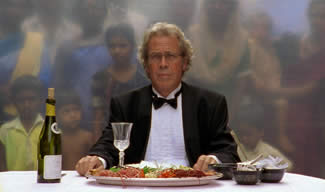
Lars von Trier is playing a new game, but this time he's not aiming his darts at you and me. At least not directly. He's aiming them at his fellow Danish filmmaker and former mentor Jørgen Leth.
His latest project is a small movie called The Five Obstructions, and although it's his first foray into documentary filmmaking, it's not really the departure that it seems to be. This isn't the first time that he's indulged a desire to tinker with the art form, and this also isn't the first time that he's sought to bring other filmmakers into his sphere of mischief. Von Trier is one of the co-drafters of a set of rules known as "Dogma 95" which promote simplicity of filmmaking, stating that "shooting must be done on location," "optical work and filters are forbidden," and so on. The manifesto made a lot of noise when it was announced, but only one of the six films that von Trier has made since 1995 has bothered to follow its rules, prompting some to assume that it was a publicity stunt, not a real attempt to make a lasting change. That's probably true, but The Five Obstructions makes the case that a set of rules might not be such a bad thing.
One of von Trier's favorite films is a 13-minute short that Leth made in 1967 called The Perfect Human, a documentary spoof in which a clinical voice narrates banal scenes from a modern man's life — while he's eating, dancing, dressing — as if he's a wildlife specimen. "It's a little gem," von Trier tells Leth in The Five Obstructions, "which we are now going to destroy." For the documentary, von Trier asks Leth to remake the film five times, each time under a set of arbitrary rules designed by von Trier to force Leth into an uncomfortable corner.
Von Trier shows how much confidence he has in Leth by launching into a seemingly disastrous first obstruction: in the new film, no shot can be longer than half a second. You'd think that would be enough, but von Trier also stipulates that Leth cannot build any sets and must shoot the film in Cuba. "This is only the first obstruction," Leth objects. "It will be a spastic film!" But he accepts the challenge, shoots the short in Cuba, and returns to Denmark with the result. A camera crew captures the process as if it's a makeover for a TV show, which means we're privy not only to Leth's shoot, but also to von Trier's stunned reaction to the new film. In his remake, Leth uses the half-second shot clock to create an elegant, rhythmic stutter. "The limit was a gift," von Trier muses.
Always a step ahead, von Trier quickly moves past simple technical limitations and aims next for Leth's psyche, putting him in increasingly unusual situations that involve traveling to Bombay for one film and Austin, Texas, for another. After imposing the fourth obstruction, von Trier confidently says that he can't see how Leth can work within its confines to make a film that's "anything other than crap."
Leth, however, seems incapable of producing "crap," and the fantastic results that he achieves under pressure not only showcase his creative skills but also his playfulness. His strength against adversity elevates the movie above the one-sided whipping of a genial man to a more interesting duel of filmmakers. He parries when von Trier thrusts. The movie may also reveal a truth about creativity in general, that an artist's best work is often produced under tight restrictions and that the brain seems to kick in when it needs to slither around them. It's an observation that may explain why so many of von Trier's own films follow similar plot lines and yet seem stylistically diverse. The rigid skeleton remains the same, but the muscles move it through a different dance each time.
The final obstruction puts von Trier himself front and center, and some critics have been surprised by how touching it is, but it resembles a standard von Trier flourish that's beginning to look like a formula. He has a talent for whipping his audience into a misty-eyed mass in the final acts of his movies, a talent that he apparently loves to wield, especially while heaping on layers of ironic detachment that stave off any accusations of sentimentality. He wields it again in this film with a final obstruction that provides a dubious explanation for why he embarked on this project in the first place. The explanation is recorded by von Trier, spoken by Leth, and written by von Trier, as he imagines Leth should say it; as in many of his recent films, von Trier seems hopeful that if his onion has enough layers, you'll be too distracted by tears to cut too deeply.
For me, the heart of the movie isn't the sudden appearance of sweetness but the creativity of both filmmakers throughout, which I believe is rooted in a love of cinema. Von Trier's penchant for provocation and emotional manipulation often overshadows his seemingly unlimited capacity for impishness, a quality that manages to hold my attention, through all of his movies, despite an occasional desire to turn away.
